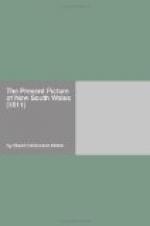According to this determination, Governor Phillip was sent to this new continent, where he arrived on the 20th of January, 1788, with eight hundred convicts, and a portion of marines, and laid the foundation of the new settlement, which continued gradually to improve under his government, until the close of the year 1792. Numberless obstructions existed, during this early period, to check the growth of the colony; amongst the principal of which may be remarked:—1st, the discordant materials of which the settlement was to be constructed; 2dly, the disputes with the natives; and 3dly, the occasional pressure of want, which, for a long time, was unavoidable, on account of its remoteness from the European quarter. The continual disorders amongst the convicts, which no lenity could assuage, no severity effectually check, were injurious to the well-doing of the colony, whose true interests required a combination of reciprocal confidence and mutual exertion; but on men inured to crime, and hardened in guilt—on men almost divested of the common principles and feelings of their species—on those whom a course of depravity had rendered obnoxious to every other pursuit, it was not possible to make impressions of a liberal and enlightened nature. Their intentions uniformly tended to vice, and no good was to be expected from them, except such as was the effect of compulsory measures; so that the task which industry might have achieved with comparative ease, proved, under existing circumstances, a work of difficulty, requiring time and perseverance to bring it to the desired perfection. It was not to the commission of depredations upon each other that the restless and dishonest dispositions of the convicts confined themselves, even the poor and miserable natives of the country were made the dupes of a system of knavery which they could not penetrate; and their spears, their shields, their canoes, and their persons, were equally exposed to the violence of the new settlers. It was easy to foresee the consequences of such conduct: the natives at first discovered symptoms of justifiable reserve, and subsequently adopted steps of an hostile complexion, several unfortunate convicts being found murdered in the woods. In vain did the governor issue order after order, and proclamation after proclamation; insults still continued to be offered to the natives, and such acts of retaliation ensued as circumstances would allow. Governor Phillip, himself, was wounded by a spear which one of the savages threw at him, under the influence of a momentary apprehension. Another evil to which the colony was subjected, arose from the pressure of occasional scarcity, which relaxed the sinews of industry, where it did exist, or strengthened the pretexts of indolence: when men were reduced from a plentiful allowance, to a weekly ration, which scarcely sufficed to preserve existence; when the storehouses were almost empty of provisions, and the boundless ocean presented no object of relief to the




